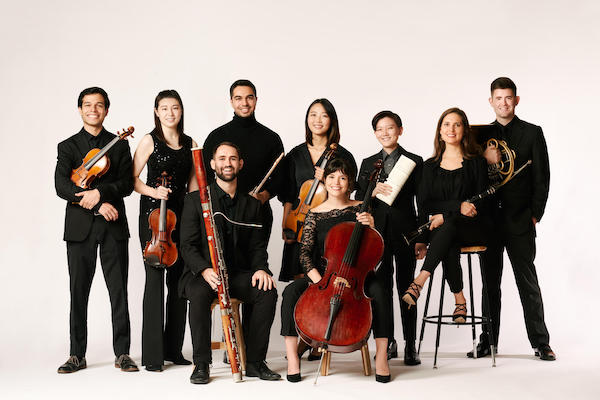Ensemble Connect swings chamber music from Coleman to Dohnányi
Ensemble Connect, Carnegie Hall’s company of young artists who do community outreach while polishing their musicianship and career skills, returns periodically to the mothership to display its growing prowess in concert.
With chamber music flavored by the popular culture of Bohemia, Hungary, Vienna and New York, Tuesday’s performance in Weill Recital Hall, by “fellows” of the program plus a few alums and guests, seemed to celebrate the players’ many visits to the neighborhoods of this city.
Fittingly, the concert began with Valerie Coleman’s Rubispheres for flute, clarinet, and bassoon, as the first section “DROM” pays tribute to the eclectic East Village music venue that invites the whole world in. Bassoonist Nik Hooks led it off with a lively soliloquy that showcased the rich, woody tone of his instrument, then laid down some riffs that brought animated commentary from flutist Amir Farsi and clarinetist Yasmina Spiegelberg.
In “Serenade,” with its expressive melody and wide Coplandesque vistas, the three instruments piled up sonorous chords until the air in the room throbbed. The laughing phrases of “Revival” chattered in tightly syncopated ensemble, the flute and clarinet letting loose with a shriek now and then while the bassoon kept its cool, in an exciting finish to a most attractive work.
The trio dynamic took a different turn in Dvořák’s Terzetto, Op. 74, for two violins and viola—Romantic chamber music in the Schumann-Brahms tradition, but more unbuttoned formally and Czech-flavored than either of those. Violinist Rubén Rengel, guest violinist Stephanie Zyzak and violist Halam Kim showed how resonant this cello-less ensemble could be in the melodious Introduzione that took the place of a sonata-form first movement.
The Larghetto swayed along three-to-a-bar, its theme coming back charmingly varied several times. The group sparkled in the fiddly, dancy Scherzo, as fast pizzicato and string-crossing propelled the first violin’s tune through some venturesome harmonies. The closing movement, a concise theme-and-variations, offered spirited interplay, sighing reflection and urgent drama before closing with an energetic coda.
In the concert’s second half, the players’ proficiency and ensemble were never in doubt, but questions of balance and tone color clouded the picture.
Arnold Schoenberg’s arrangement for chamber ensemble of the Kaiser Waltz by Johann Strauss Jr. was meant as a sweet appetizer for a performance of his melodrama Pierrot Lunaire. But Tuesday’s performance–by flutist Farsi, clarinetist Spiegelberg, violinist Zyzak, pianist Joanne Kang, cellist Laura Andrade, and two program alums, violinist Suliman Tekalli and violist Caeli Smith–could have used another spoonful of sugar.
The players drummed and strutted in the opening imperial march, and when the waltz began they crafted phrases and flexed tempos in the Straussian manner. But a blanket of Brahmsian sobriety—perhaps as attributable to the arrangement as to the playing—lay over the whole scene. One wished the group had found a more airy, silky sound to go with their artful rubato.
Brahms-like sonorities were not a problem in Ernst von Dohnányi’s Sextet in C major, Op. 37; this composer invites them. But the difficulty of integrating a horn with strings and piano was overcome only at times in this performance. Cort Roberts’s horn was startlingly loud at its first entrance, and while he modulated it well at other points, overall it contributed, with Kang’s piano, to a performance that sounded more clattery than sonorous, and too big for the tiny recital hall.
Strings have long had their issues with Brahms’s, and Brahms-influenced, chamber music with piano. To the partial eclipse of string players Rengel, Kim and Andrade on Tuesday must be added the frequent struggle of clarinetist Spiegelberg to be heard. But as the substantial first movement unfolded, with its turbulent and songful episodes and rhapsodic climaxes, one could hear the group playing more freely and warmly.
The slow Intermezzo opened with just piano and strings, a relief to the ear. The gladiatorial march that followed had a somewhat harsh tone, perhaps owing to intonation issues between horn and clarinet. In the Scherzo the clarinet found the spotlight at last, tripping lightly “con sentimento,” as in some of Brahms’s graceful third movements. The eventful Finale also danced, with an infectiously jazzy main theme, and seemed to end about four times before it finally did.
The concert’s presentation echoed the communicative mission of Ensemble Connect. Most musicians would rather play their instrument than do public speaking, but on Tuesday each piece was preceded by a player saying a few words about it. Attire was thought out as well: generally jackets and no ties for the men, smart dresses but not gowns for the women, an aesthetic somewhere between the youthful, approachable vibe of the people onstage and the massive crystal chandeliers overhead.
Ensemble Connect and the Sandeep Das and Mike Block Duo perform in “Sangam, A Confluence of Musical Rivers, with improvisations based on music from India, Nepal, Greece, Finland, Norway, and the U.S., 7:30 p.m. May 8 in Resnick Education Wing, Carnegie Hall. carnegiehall.org.
